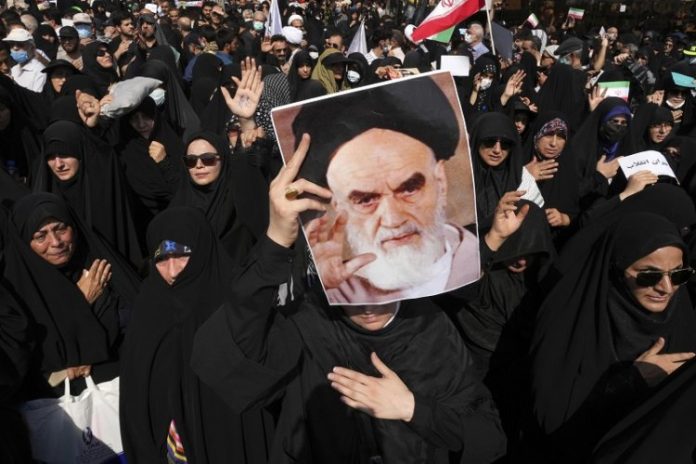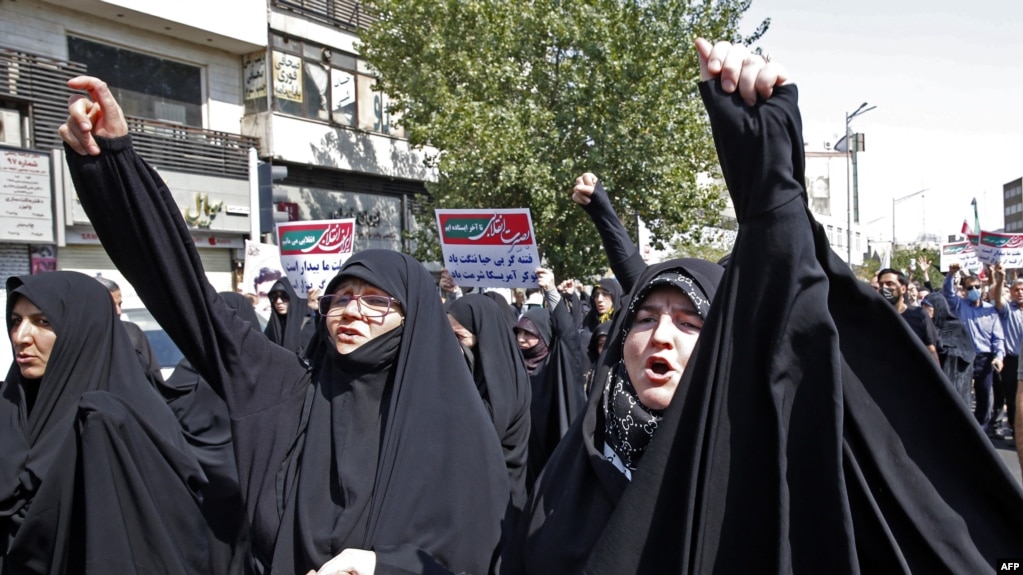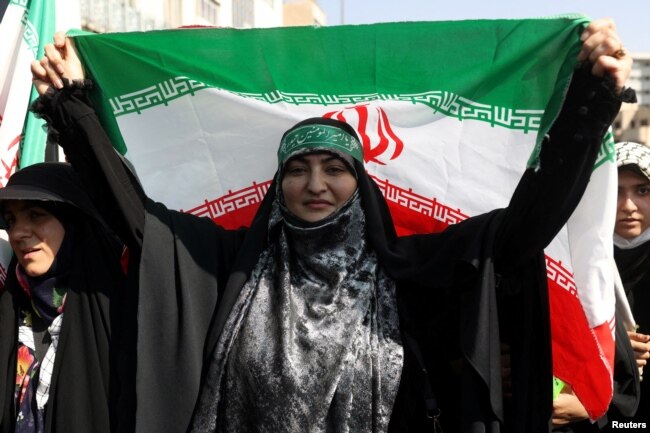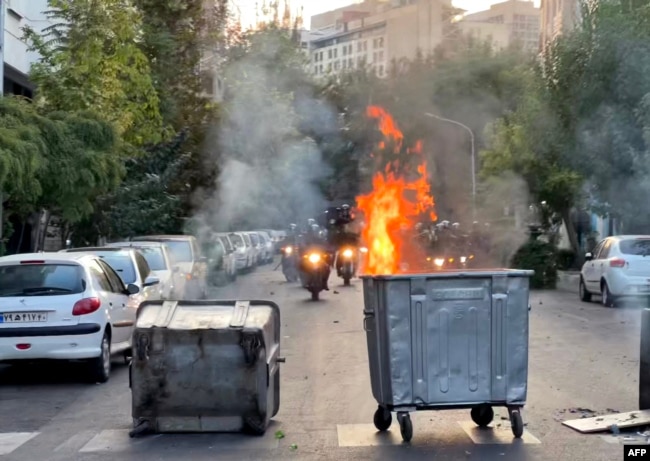Two Tehrans have been on show since Mahsa Amini died in morality police custody last week — the city of black-clad women castigating “improper” dress and a rival city that resents being told what to wear.
For the past week since the 22-year-old’s death three days after being arrested for wearing the Islamic headscarf “improperly,” protesters have taken to the streets each evening in various parts of the capital.
According to images spread on social media, female demonstrators have even taken off their headscarves and burned them in protest at the omnipresent morality police charged with enforcing the dress code Amini was alleged to have breached.
Under rules imposed shortly after the Islamic revolution of 1979, women are required to conceal their hair with a headscarf and to wear loose fitting trousers under their coats. Ripped jeans and less than full-length trousers are banned.
On Friday, outside Tehran University, supporters of the mandatory dress code gathered for a counter-rally not far from Hijab Street, one of the locations of nightly protests.
Women clad in black cloaks joined men brandishing the Islamic republic flag and placards expressing appreciation for the security forces.
“For many opponents of the morality police, the hijab issue is just a pretext to disrupt our country’s security,” complained the prayer leader of a nearby mosque, wearing the black turban that is the mark of a descendant of the prophet Mohammed.
“Wearing the headscarf is part of Iranians’ national and religious identity,” said the 40-year-old cleric, who gave only his family name Nadali.
“Certainly, the way the morality police work needs to be reviewed but it’s not going to be put right by rioting.”
Other demonstrators nodded their approval but when the cleric asserted that “the real Iranians are the people gathered here today,” a student from the nearby polytechnic university interrupted him.
“We are all one people, one nation,” retorted Hossein Zarin-Eghbal, 24, who nonetheless said he had joined the counter-demonstration in response to a call from the Islamic Development Coordination Council, one of Iran’s revolutionary institutions.
“I was saddened by Mahsa Amini’s death. I came to support the Islamic republic, not the morality police, because I believe that they do need to be reformed.”
Burning bins
In the streets around the university, the charred remains of truck tires burned by protesters were still visible on the highway and the rubbish bins had all been removed to be set alight.
“We have a problem in this country. We have no mechanism for protest in Iran,” said Zarin-Eghbal, who said he could understand the anger of his fellow citizens even though he opposed their resort to violence.
“During the 43 years of the Islamic republic, not once has the government allowed people to hold a peaceful demonstration to criticize the main tenets of the political establishment,” he said.
READ ALSO: Iran: IRGC attacks terrorists’ positions in Iraqi Kurdistan
Near Parkway Bridge, in a well-to-do Tehran neighborhood, Fatemeh, 37, said she had taken part in the protests triggered by Amini’s death.
“The Islamic republic, our [supreme] leader and our president should hear the people.”
According to a report, Iranian counterprotesters gathered across the country on Friday in a show of support for authorities after nearly a week of anti-government protests and unrest over the death of a young woman who was being held by the morality police.
A few thousand people attended a rally in the capital, Tehran, where they waved Iranian flags, and similar demonstrations were held in other cities. The government claimed the demonstrations of support were spontaneous. Similar rallies have been held during past periods of widespread protests.
The pro-government demonstrators chanted against America and Israel, according to state media, reflecting the official line that foreign countries are fomenting the latest unrest.
State TV, meanwhile, suggested the death toll from this week’s unrest could be as high as 26. Anti-government protesters and security forces have clashed in several major cities in the most severe political unrest since 2019, when rights groups say hundreds were killed amid demonstrations against a hike in state-controlled gasoline prices.
Iran has also disrupted internet access and tightened restrictions on popular platforms used to organize rallies like Instagram and WhatsApp.
A state TV anchor said late Thursday that 26 protesters and policemen had been killed since the protests erupted last Saturday after the funeral of the 22-year-old Mahsa Amini, without elaborating on how authorities reached that figure. He said official statistics would be released later, but during past periods of unrest authorities have not provided a full accounting of deaths and injuries.
A tally by The Associated Press, based on statements from state-run and semiofficial media, shows that at least 11 people have been killed. Most recently, the deputy governor of Qazvin, Abolhasan Kabiri, said that a citizen and paramilitary officer had been killed in unrest that rocked two cities in the northwestern province.
The crisis unfolding in Iran began as a public outpouring of anger over the the death of Amini, a young woman who was arrested by the morality police in Tehran last week for allegedly wearing her Islamic headscarf too loosely. The police said she died of a heart attack and was not mistreated, but her family has cast doubt on that account.
Amini’s death has sparked sharp condemnation from Western countries and the United Nations, and touched a national nerve. Hundreds of Iranians across at least 13 cities from the capital, Tehran, to Amini’s northwest Kurdish hometown of Saqez have poured into the streets, voicing pent-up anger over social and political repression. Authorities have alleged that unnamed foreign countries and opposition groups are trying to foment unrest.
The death has tapped into broader antigovernment sentiment in the Islamic Republic and especially the frustration of women, wrote political risk firm Eurasia Group, noting that Iran’s hard-liners have intensified their crackdown on women’s clothing over the past year since former judiciary chief Ebrahim Raisi became president.
The prospect of the leadership offering concessions to Iranian women is minimal, it said. In the cold calculus of Iranian leaders, the protests have likely gone far enough and a more forceful response is required to quell the unrest.
Videos on social media show protesters in Tehran torching a police car and confronting officers at close range. Elsewhere in the capital, videos show gunfire sounding out as protesters bolt from riot police, shouting: They are shooting at people! Oh my God, they’re killing people!
In the northwestern city of Neyshabur, protesters cheered over an overturned police car. Footage from Tehran and Mashhad shows women waving their obligatory headscarves, known as hijab, in the air like flags while chanting, Freedom!”
The scenes of women cutting their hair and burning their hijabs feed into a broader political debate over the role of religious strictures in a modern-day republic questions that have plagued the Islamic Republic since its founding in 1979.
But the protests have also grown into an open challenge to the government. The chants have been scathing, with some chanting Death to the dictator! and Mullahs must be gone!
Iran’s intelligence ministry warned citizens against joining the illegal street rallies on Thursday, threatening prosecution. Local officials have announced the arrest of dozens of protesters. Hasan Hosseinpour, deputy police chief in the northern Gilan province, reported 211 people detained there on Thursday. The government of the western Hamadan province said 58 demonstrators had been arrested.
Tehran University announced that it would move classes online for the next week amid the unrest, the semiofficial Fars news agency reported.
London-based watchdog Amnesty International has accused security forces of beating protesters with batons and firing metal pellets at close range. Videos show police and paramilitary officers using live fire, tear gas and water cannons to disperse the demonstrations.
Iran has grappled with waves of protests in the recent past, mainly over a long-running economic crisis exacerbated by American sanctions linked to its nuclear program. In November 2019, the country saw the deadliest violence since the 1979 Islamic Revolution, as protests erupted over gas price hikes.
Economic hardship remains a major source of anger today as the prices of basic necessities soar and the Iranian currency declines in value.
The Biden administration and European allies have been working to revive the 2015 Iran nuclear accord, in which Iran curbed its nuclear activities in exchange for sanctions relief, but the talks have stalled for months.
The Eurasia Group said the protests make any immediate return to the agreement less likely, as Iran’s government will be more hesitant to make concessions at a time of domestic unrest and the United States will be reluctant to sign a deal as Iran violently cracks down on dissent.
















